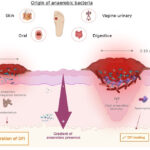Enterobacter species, particularly Enterobacter cloacae and Enterobacter aerogenes, are significant pathogens in hospital-acquired infections, frequently implicated in bloodstream infections and sepsis. These Gram-negative bacilli are members of the Enterobacteriaceae family and are commonly associated with multidrug resistance, complicating management in critically ill patients.

Microbiology and Resistance Mechanisms of Enterobacter
Bacterial Characteristics
Enterobacter species are facultative anaerobes that colonize the gastrointestinal tract and can become opportunistic pathogens under immunocompromised or invasive procedural conditions. They possess:
- Motility via peritrichous flagella
- Lactose fermentation on MacConkey agar
- Natural AmpC β-lactamase production
Antimicrobial Resistance in Enterobacter
A critical challenge in treating Enterobacter-related sepsis is its ability to develop resistance, especially under antibiotic pressure.
- AmpC β-lactamases: Inducible or constitutive resistance to cephalosporins.
- Extended-Spectrum β-Lactamases (ESBLs): Confer resistance to penicillins, cephalosporins, and aztreonam.
- Carbapenemases (e.g., KPC, NDM): Result in resistance to carbapenems, necessitating last-resort agents.
Pathogenesis of Sepsis Caused by Enterobacter
Upon entry into the bloodstream via catheter-related infections, respiratory devices, or post-surgical wounds, Enterobacter initiates a systemic inflammatory response characterized by:
- Cytokine storm: IL-6, TNF-α activation
- Endotoxin (LPS) release: Triggers coagulation cascade and vascular leakage
- Organ dysfunction: Due to hypotension, microvascular thrombosis, and hypoperfusion
Risk Factors for Enterobacter Sepsis
- Prolonged hospitalization or ICU stay
- Broad-spectrum antibiotic exposure
- Invasive devices (e.g., central lines, ventilators)
- Immunosuppression (e.g., chemotherapy, transplantation)
- Recent surgery or trauma
Clinical Presentation and Diagnostic Evaluation
Signs and Symptoms
- Fever, chills, hypotension
- Tachycardia, altered mental status
- Leukocytosis or leukopenia
- Signs of localized infection (e.g., pneumonia, intra-abdominal infection)
Laboratory and Microbiological Diagnosis
- Blood cultures (aerobic and anaerobic sets)
- Procalcitonin, CRP: Indicators of systemic inflammation
- Lactate levels: Marker of tissue hypoperfusion
- Antibiotic susceptibility testing: Essential for guiding therapy
Imaging and Source Localization
- CT or MRI: To detect abscesses, pneumonia, or device-related infections
- Ultrasound: For evaluating fluid collections, especially in the abdomen or pelvis
- Echocardiography: In cases of suspected endocarditis
Antimicrobial Treatment Strategies
Empiric Therapy (Pre-culture Results)
- Piperacillin-tazobactam
- Meropenem (in high-risk or resistant settings)
- Cefepime (caution with AmpC-producing strains)
Directed Therapy (Post-susceptibility Testing)
| Resistance Profile | Preferred Antibiotics |
|---|---|
| AmpC-positive | Carbapenems, Cefepime |
| ESBL-producing | Meropenem, Ertapenem |
| Carbapenem-resistant | Ceftazidime-avibactam, Meropenem-vaborbactam, Colistin (if needed) |
Duration of Therapy
- Uncomplicated bacteremia: 7–10 days
- With endocarditis or abscess: 4–6 weeks
- Duration guided by source control, immune status, and clinical response
Infection Control and Prevention
- Strict hand hygiene and contact precautions
- Antibiotic stewardship programs: Prevent selection pressure
- Removal of unnecessary devices
- Routine surveillance cultures in ICU settings
Outcomes and Prognostic Indicators
Mortality and Complications
- Crude mortality of Enterobacter sepsis ranges from 15%–35%, higher in MDR strains
- Risk of septic shock, multi-organ failure, and recurrent infections in resistant cases
Predictors of Poor Prognosis
- Delayed appropriate antibiotic therapy
- Underlying immunosuppression
- Persistent bacteremia despite treatment
- Absence of source control
Emerging Therapies and Research Directions
- Beta-lactam/beta-lactamase inhibitor combinations (e.g., ceftolozane-tazobactam)
- Phage therapy: Investigational in MDR Enterobacter
- Rapid diagnostics: PCR and MALDI-TOF improving identification and resistance detection
- Vaccines and monoclonal antibodies: Under early-phase research
Sepsis caused by Enterobacter remains a formidable challenge due to its association with multidrug resistance and nosocomial settings. Prompt recognition, accurate pathogen identification, tailored antimicrobial therapy, and rigorous source control are fundamental to improving patient outcomes. As resistance continues to evolve, reliance on novel diagnostics and therapeutic agents will be pivotal in managing these complex infections effectively.

